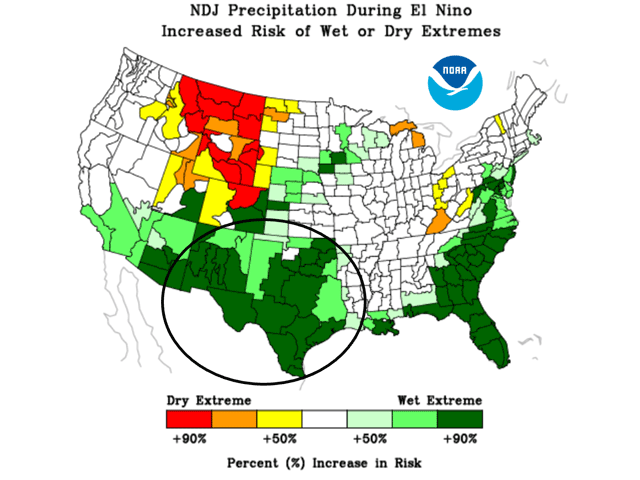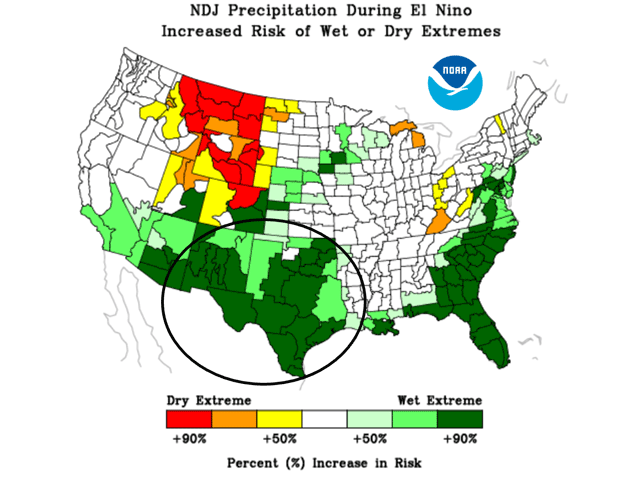Ag Weather Forum
El Nino Brings Southern Plains Drought Relief
The first ratings of the 2023-24 United States winter wheat crop show some sharp improvement in the U.S. Southern Plains compared to a year ago. The Texas wheat crop boasts a 41% good to excellent total, much higher than last year's late-October total of only 4% good to excellent. The Oklahoma wheat crop rates 42% good to excellent compared with only 11% good to excellent a year ago. The Kansas wheat crop rating of 32% good to excellent is a full eight percentage points more than 24% good to excellent at the end of October in 2022.
The reason for those robust conditions is easy to spot; significant precipitation to get the new crop jump-started. "Most of Oklahoma has received significant rain in the past week reviving hopes for wheat pasture," wrote Oklahoma State University livestock economist Derrell Peel in a newsletter Oct. 30. "The majority of the state was blessed with 1.5 to over 6 inches of rain." The wet week in late October continued to show evidence of a more active weather pattern for the Southern Plains, following some good rains in September and in early October.
Additional precipitation is forecast through the winter in the region. In fact, the Southern Plains weather pattern during the past summer and now into the fall has gone according to long-term tendencies with El Nino, according to a NOAA Southern Plains drought update briefing on Oct. 26. The briefing summary noted that:
P[L1] D[0x0] M[300x250] OOP[F] ADUNIT[] T[]
-- El Nino conditions are present in the central Pacific and are anticipated to continue through the Northern Hemisphere winter.
-- Each El Nino has affected the Southern Plains weather differently, but on average, when a strong El Nino pattern is in place, the Southern Plains experiences a dry summer followed by a wet winter.
-- El Nino was one factor in the extended drought conditions this summer. Past events indicate increased rainfall can be expected in late fall and early winter this year.
NOAA/Climate Prediction Center historical records indicate that the Southern Plains has anywhere from a 60 to 90% chance of wet conditions during the November-to-January period when El Nino is in effect. As far as amounts relative to normal are concerned, DTN's forecast during those three months calls for precipitation totals of from 0.05 to 2 inches above normal in the region.
This moisture will be important, because drought is still a big feature in the Southern Plains. As of Oct. 24, the U.S. Drought Monitor indicated that 72% of the Southern Plains region is in drought (D1 or worse), a 27% increase from three months ago. Also, 25% of the region is experiencing Extreme (D3) drought or worse. And, for the year to date, much of eastern Kansas has precipitation totals which are at least 10 inches below normal. Oklahoma had 90-day precipitation deficits of from 4 to 8 inches prior to the latest rainfall. And, in western and southern Texas, water reservoir levels remain at or near all-time lows for this time of year; streamflows are also at or near all-time lows.
So, El Nino has helped bring some fall rains to the Southern Plains. The question is, can the spigot stay on to make a long-lasting dent in long-lasting drought?
Bryce Anderson can be reached at Bryce.Anderson@dtn.com
Follow him on X, formerly known as Twitter, @BAndersonDTN
(c) Copyright 2023 DTN, LLC. All rights reserved.






Comments
To comment, please Log In or Join our Community .